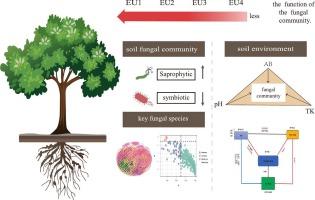以稀有和丰富真菌种类为主的共生网络影响了尾叶桉人工林真菌群落的潜在功能
IF 5
2区 农林科学
Q1 SOIL SCIENCE
引用次数: 0
摘要
尾叶桉连作对土壤真菌群落组成有显著影响。然而,作为群落组成的主要贡献者,丰富和稀有物种如何受到上述种植模式的影响尚不清楚。本研究旨在调查尾叶连作对丰富和罕见的真菌类群的影响,并找出影响真菌类群的驱动因素。在广西大桂山林场建立了第一代至第四代尾叶松人工林和阔叶林。利用共现网络分析识别关键类群,并利用偏最小二乘路径模型揭示影响其主要驱动力。结果表明,连作改变了土壤中的稀有真菌。与丰种相比,稀有种具有更高的平均度和中间度中心性,其中腐生菌占据重要节点,但随着种植世代的增加,某些致病真菌也呈现明显的上升趋势。伞形opsis和Russula是共生菌,随着种植的连作而显著减少。土壤中全钾(TK)和速效硼浓度以及pH值是直接影响关键类群的重要驱动因子。结果表明,连续种植尾叶蕨扰乱了稀有真菌的原始状态。真菌群落的功能呈现出共生真菌减少、腐生真菌和致病真菌增加的变化趋势。综上所述,尾叶桉人工林的可持续管理应通过调节土壤pH和钾含量,减少对土壤的过度干扰,保留采收残留物,恢复真菌群落平衡,缓解连作障碍。本文章由计算机程序翻译,如有差异,请以英文原文为准。

Co-occurrence networks dominated by rare and abundant fungal species influence the potential function of fungal communities in Eucalyptus urophylla plantations under successive planting
The successive planting of Eucalyptus urophylla significantly disturbs soil fungal community composition. However, little is known about how abundant and rare species, the main contributors to community composition, are affected by the above planting pattern. We aim to investigate the abundant and rare fungal taxa affected by the successive planting of E. urophylla and identify the driving factors affecting them. First-to-fourth generations of E. urophylla plantations and a broad-leaved forest were established in Guangxi State Daguishan Forest Farm in southern China. We used co-occurrence network analysis to identify key taxa and employed partial least squares path modeling to reveal the main driving force affecting them. Results showed that successive planting altered rare fungi in the soil. Compared with abundant species, rare species had a higher average degree and betweenness centrality, in which saprophytes occupy important nodes but some pathogenic fungi also exhibited a marked upward trend with increasing planting generations. Umbelopsis and Russula were symbiotrophs and decreased significantly with successive planting. The concentrations of total potassium (TK) and available boron in the soil, as well as pH, were important driving factors that directly affected the key taxa. Our results suggest that the successive planting of E. urophylla disturbed the primitive status of rare fungi. The function of the fungal community tended to change with the decrease in symbiotic fungi and increase in saprophytic and pathogenic fungi. Based on the above research, the sustainable management of Eucalyptus urophylla plantations should regulate soil pH and potassium content, reduce excessive soil disturbance, and retain harvest residues to restore the balance of fungal communities and alleviate successive planting obstacles.
求助全文
通过发布文献求助,成功后即可免费获取论文全文。
去求助
来源期刊

Applied Soil Ecology
农林科学-土壤科学
CiteScore
9.70
自引率
4.20%
发文量
363
审稿时长
5.3 months
期刊介绍:
Applied Soil Ecology addresses the role of soil organisms and their interactions in relation to: sustainability and productivity, nutrient cycling and other soil processes, the maintenance of soil functions, the impact of human activities on soil ecosystems and bio(techno)logical control of soil-inhabiting pests, diseases and weeds.
 求助内容:
求助内容: 应助结果提醒方式:
应助结果提醒方式:


